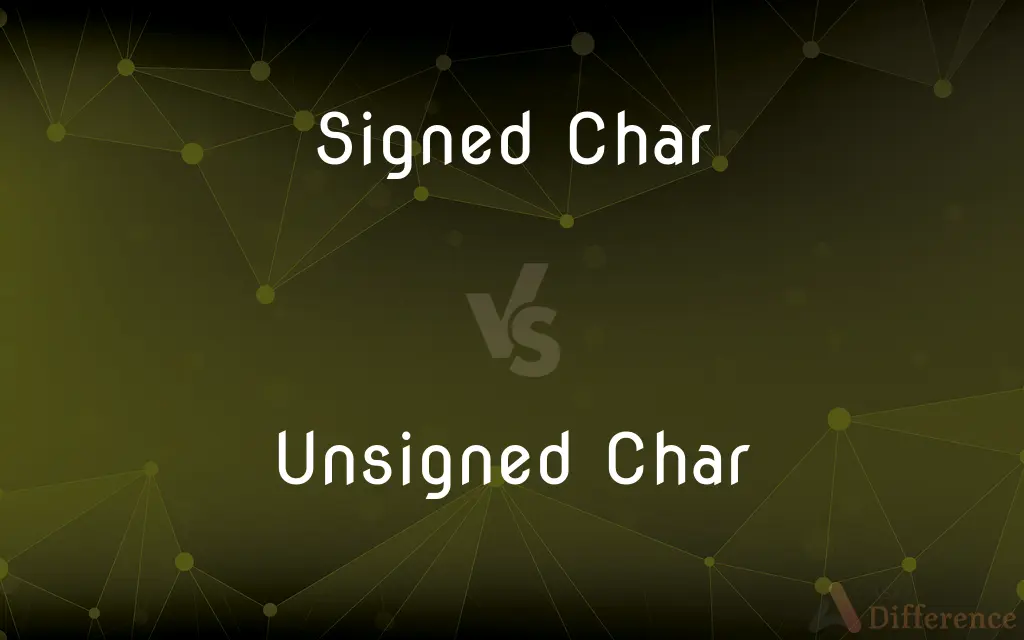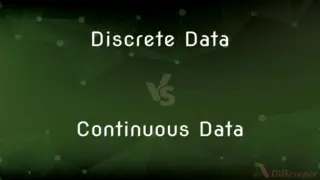Signed Char vs. Unsigned Char — What's the Difference?
Edited by Tayyaba Rehman — By Fiza Rafique — Published on December 18, 2023
Signed Char represents both positive and negative values, while Unsigned Char only represents positive values and zero.

Difference Between Signed Char and Unsigned Char
Table of Contents
ADVERTISEMENT
Key Differences
A Signed Char, in computing, is a data type that can hold both negative and positive integer values. On the contrary, an Unsigned Char is designed to only represent non-negative integer values, including zero. The differentiation comes in the way binary representation is interpreted.
The primary distinction between a Signed Char and an Unsigned Char is the range of values they can represent. Because Signed Char caters to both negative and positive numbers, it typically has a reduced positive range compared to Unsigned Char, which uses all bits for positive values.
In many programming languages, when developers declare a character variable as a Signed Char, they are signaling the system that the variable might store negative values. Conversely, declaring a variable as an Unsigned Char means that the variable will only hold positive values or zero. This distinction aids in efficient memory usage and data processing.
From a binary perspective, the leading bit in a Signed Char often acts as a sign bit, determining whether the value is positive or negative. However, for an Unsigned Char, every bit is used to determine the magnitude of the value, thus offering a larger positive range.
When doing arithmetic operations, understanding the difference between Signed Char and Unsigned Char is crucial. Operations on a Signed Char can lead to both positive and negative results. In contrast, operations on an Unsigned Char will always yield non-negative results, which can sometimes lead to unexpected outcomes if not handled correctly.
ADVERTISEMENT
Comparison Chart
Value Range
Both negative and positive
Only positive values including zero
Leading Bit
Often used as a sign bit
Used to determine value's magnitude
Typical Usage
When negative values are expected
When only non-negative values are expected
Risk of Overflow/Underflow
Both overflow and underflow possible
Only overflow possible
Memory Representation
One bit for sign, rest for value
All bits represent the value
Compare with Definitions
Signed Char
A binary data type having a designated sign bit.
In the array, each Signed Char represented an elevation, including below sea level.
Unsigned Char
A binary data type without a designated sign bit.
Each item in the data sequence was an Unsigned Char, showing the count of occurrences.
Signed Char
A data type using one bit for the sign.
Due to the sign bit, the maximum positive value of the Signed Char was reduced.
Unsigned Char
A variable devoid of a sign, always positive or zero.
The pixel intensity was stored as an Unsigned Char.
Signed Char
A character data type with both negative and positive values.
In the application, the Signed Char was used to denote temperature variations.
Unsigned Char
A data type utilizing all bits for value magnitude.
The memory used by the Unsigned Char efficiently stored the age of each person.
Signed Char
A character representation with a specified sign.
The programmer chose Signed Char to accommodate the range of values.
Unsigned Char
A character representation with no sign distinction.
The sensor readings were stored as Unsigned Char for simplicity.
Signed Char
A variable capable of storing negative integers.
The algorithm used a Signed Char to handle the balance adjustments.
Unsigned Char
A character data type representing only non-negative values.
For the color values, an Unsigned Char was utilized.
Common Curiosities
Can Signed Char represent zero?
Yes, both Signed Char and Unsigned Char can represent zero.
Which has a larger positive range: Signed Char or Unsigned Char?
Unsigned Char has a larger positive range as all its bits represent value magnitude.
Why would one choose to use Unsigned Char?
Unsigned Char is used when only non-negative values are expected, optimizing memory usage.
Does Signed Char use one bit for sign representation?
Yes, typically, one bit in a Signed Char is used as a sign bit.
Can a Signed Char cause underflow?
Yes, if a value goes below the range, it can cause underflow.
Are there performance differences between Signed Char and Unsigned Char?
Performance differences are minimal but can arise due to sign checking with Signed Char.
Is there a memory size difference between Signed Char and Unsigned Char?
No, both occupy the same amount of memory, but they interpret the stored value differently.
In which scenarios is Signed Char more suitable?
Signed Char is suitable when there's a possibility of both negative and positive values, like temperature deviations.
Can arithmetic operations on Unsigned Char yield negative results?
No, operations on Unsigned Char will always result in non-negative outcomes.
What's the key difference between Signed Char and Unsigned Char?
Signed Char can hold both negative and positive values, while Unsigned Char represents only non-negative values.
What happens when a value exceeds the range of Unsigned Char?
It causes overflow, wrapping the value around to start from zero.
Which data type is better for representing color channels?
Unsigned Char is typically preferred for color channels as values are non-negative.
Can the range of Unsigned Char be doubled by making it signed?
No, making it signed divides the range between negative and positive values.
Can Unsigned Char represent negative values?
No, Unsigned Char can only represent positive values and zero.
In what scenarios might Signed Char lead to unexpected results?
If not handled correctly, operations on Signed Char can result in overflow or underflow.
Share Your Discovery

Previous Comparison
Discrete Data vs. Continuous Data
Next Comparison
Alaskan Husky vs. Siberian HuskyAuthor Spotlight
Written by
Fiza RafiqueFiza Rafique is a skilled content writer at AskDifference.com, where she meticulously refines and enhances written pieces. Drawing from her vast editorial expertise, Fiza ensures clarity, accuracy, and precision in every article. Passionate about language, she continually seeks to elevate the quality of content for readers worldwide.
Edited by
Tayyaba RehmanTayyaba Rehman is a distinguished writer, currently serving as a primary contributor to askdifference.com. As a researcher in semantics and etymology, Tayyaba's passion for the complexity of languages and their distinctions has found a perfect home on the platform. Tayyaba delves into the intricacies of language, distinguishing between commonly confused words and phrases, thereby providing clarity for readers worldwide.














































